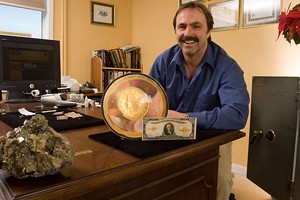Published April 7, 2010 at 9:34 a.m.
I arrived at Martin’s Coins & Jewelry in South Burlington with a Ziploc bag full of old coins and fantasies of an early retirement. After my grandfather died, I inherited the foreign currency he’d accumulated over decades of travel: bills and coins from Israel, Morocco, Portugal and Venezuela, to name but a few. Surely somewhere amid all these lirot, francs, centimos and bolivares was something of real value.
John K. Martin Jr. was my go-to expert. A professional numismatist and coin dealer, Martin has 20 years of experience getting Vermonters top dollar for their rare and precious coins. Lately, about half his business has been buying and selling scrap gold and silver, jewelry, diamonds, and watches. The reason: The recession has cut into the number of coin collectors willing to shell out new green for old silver.
Martin’s shop, sandwiched between the Book Worm’s Exchange and Jiffy Lube on Shelburne Road, is small and unpretentious, with display cases full of Silver Certificates, Indian Heads and other minted oddities. I saw a 1955 “double die” penny, with dual images of Lincoln on its face. A 25-cent gold piece from 1872, valued at $2500, was about the size of my pinky nail. Another double die, an Indian Head from 1873, was listed at $5000. My palms started getting itchy.
Martin, 48, had agreed to review my collection. Naturally, I assumed the oldest coins were worth the most: French francs minted during the Vichy years, a pre-Franco Spanish peseta and a Haitian coin from 1908 all looked promising to my untrained eye.
Martin quickly burst my bubble. It really boils down to supply and demand, he explained. Coins may be very scarce, but if no one collects them, they have little or no value. He looked up one of my coins on the “gray sheet,” the weekly bible for serious collectors. Minted in 1937, it was from Norway and 80 percent silver. After tapping away on his calculator, he announced its market value: $3.30.
The news was even worse on the 1908 Haitian coin. “It starts in the catalog at a buck and a quarter,” Martin declared. “Maybe you can get a dollar. On a good day.” My heart sank.
The really valuable coins, he explained, typically contain gold or silver, like the South African Krugerrands and the Canadian Maple Leafs. They’re actively traded, “like the stock market,” and valuations can fluctuate $50 in one day.
Then there are the collectibles. Minting mishaps, such as the double dies and offset faces, can net you serious bucks, Martin noted, as can “waffled” coins, which somehow made it into circulation after the mint ran them through a press to destroy them. The “grade,” or condition, of the coin makes a difference, as does its “relief,” or detail. Either can swing a coin’s value from $26 to $20,000.
My coins? Only three had any precious metals in them, and none would spark the slightest interest in a collector over the age of 10. Martin suggested I sell them by the pound. Even at that rate, I’d be lucky to get 20 bucks for the lot.
Guess I should plan on working for a while.
SEVEN DAYS: Were you a collector as a kid?
JOHN MARTIN JR.: Not really. I was kind of a wheeler-dealer as a kid. I’d bring a bag of candy to school, pay 10 cents for a stick of gum and sell it for a quarter. I had my own business where I sold night crawlers. And I’d knock on people’s doors to see if they needed something, like their driveway shoveled.
SD: What’s your training as a numismatist?
JM: I went to Colorado for four summers in a row and took seminars on coin grading and counterfeit detection. That’s where I feel I have an edge on the competition. There’s a lot of guys who do this whose education is based on experience of just buying and selling, or books they’ve read.
SD: Is coin trading a regulated industry?
JM: It’s not. Anyone can put a sign outside their house that says, “We buy and sell coins.” It’s definitely a type of business where you need to do a little research before you sit down with someone and put your stuff out there, to find out how long they’ve been doing this, what’s their experience and where their education comes from.
SD: Are most coins bought and sold for the raw metal or for the collector value?
JM: You have bullion-related coins, and you have numismatic coins. Bullion-related coins are your Maple Leafs, your Krugerrands, your gold Eagles, that trade just over the spot price. But when you have numismatic coins, that means they have value substantially over and above their gold value. Some coins can bring 100 times their gold value. So, you got a $20 gold piece and it’s nearly one ounce of gold, it may be a $7000 or $8000 coin.
SD: What are common mistakes people make with old coins?
JM: A lot of times people relate coins to antiques. They think that if a coin is 100 years old, it’s got to be a super-valuable coin. But there are a lot of coins that are 100 years old. For example, a common-date Morgan dollar you can buy for $16 or $17 in well-worn condition. There’s $13 in silver alone in it. So, even though it’s 100 years old, it’s still only worth a few dollars over the silver value.
SD: Should people clean their old coins?
JM: That’s something not to do. I’ve see coins come in here that would be worth thousands of dollars that somebody cleaned and turned into a $300 coin. They thought they were doing themselves a favor. The original luster is from when the coin is struck. There are flow lines of the metal ... You take a bottle of silver polish and start wiping it, it still looks silver, but it looks like a chrome bumper.
SD: How does that affect its value?
JM: I had an older couple [whose] father found a coin in a pipe in New York City. It was a wire-edged 1907 Indian Head gold piece ... I told them I thought it was worth $8000 to $10,000. It would have been worth $18,000 or $19,000 if it had not been cleaned. But somebody probably scoured that coin with an S.O.S. pad when it came out of the pipe. So there are hair lines all over it. I ended up getting $9500 for them.
SD: Tell me about your best rare finds.
JM: I had a Vermont Colonial copper coin that I sold for $30,000. It’s an old copper coin from 1787 ... I had a high-relief gold piece that I sold recently for $27,500 ... There are only 20 of them known. There were 19 known before that.
SD: What do you recommend to someone who has old coins but no knowledge of their worth?
JM: If you’re looking to sell them, I’d highly recommend getting a few different offers before dropping them at the first place you go. There are a lot of different levels of knowledge in the area. Somebody who doesn’t know a lot about coins might miss a really great coin in your collection.
John K. Martin Jr.
Town
South Burlington
Job
Certified numismatist, Martin’s Coins & Jewelry
Age/Years Worked
48/20 years full time in the business
The Money Issue
It's not keeping us awake at night, like it was last year, but money is always an issue. The last 28 months have been an endless lesson in short selling, credit default swaps and underwater mortgages. Are we any smarter as a result? Let's hope. In that spirit, our Money Issue underscores financial matters in Vermont, where Mark Young lives in the bank he owns in Orwell. Meanwhile, in Montpelier, National Life's bond-trading floor is as close to Wall Street as you can get. Burlington sure could use some of those billions. Kevin Kelley analyzes the city's moneyman, Jonathan Leopold, whose frugality rep is now in question. Along those lines, we've included three budget-stretching stories: Ken Picard offers up his coin collection for evaluation; our food writers compare cheap-eating strategies; and Alice Levitt blows $20 at South Burlington's new Goodwill store.
More By This Author
About the Artist

Matthew Thorsen
Bio:
Matthew Thorsen was a photographer for Seven Days 1995-2018. Read all about his life and work here.
Matthew Thorsen was a photographer for Seven Days 1995-2018. Read all about his life and work here.
Speaking of...
-

Home Is Where the Target Is: Suburban SoBu Builds a Downtown Neighborhood
Apr 16, 2024 -

State Will Build Secure Juvenile Treatment Center in Vergennes
Apr 15, 2024 -

Pauline's Café Closes in South Burlington After Almost Half a Century
Apr 15, 2024 -

After 33 Years, Cheese & Wine Traders in South Burlington Shutters Abruptly
Apr 1, 2024 -

Nikki Haley Plans Campaign Stop in Vermont on March 3
Feb 26, 2024 - More »
Comments
Comments are closed.
From 2014-2020, Seven Days allowed readers to comment on all stories posted on our website. While we've appreciated the suggestions and insights, right now Seven Days is prioritizing our core mission — producing high-quality, responsible local journalism — over moderating online debates between readers.
To criticize, correct or praise our reporting, please send us a letter to the editor or send us a tip. We’ll check it out and report the results.
Online comments may return when we have better tech tools for managing them. Thanks for reading.












































